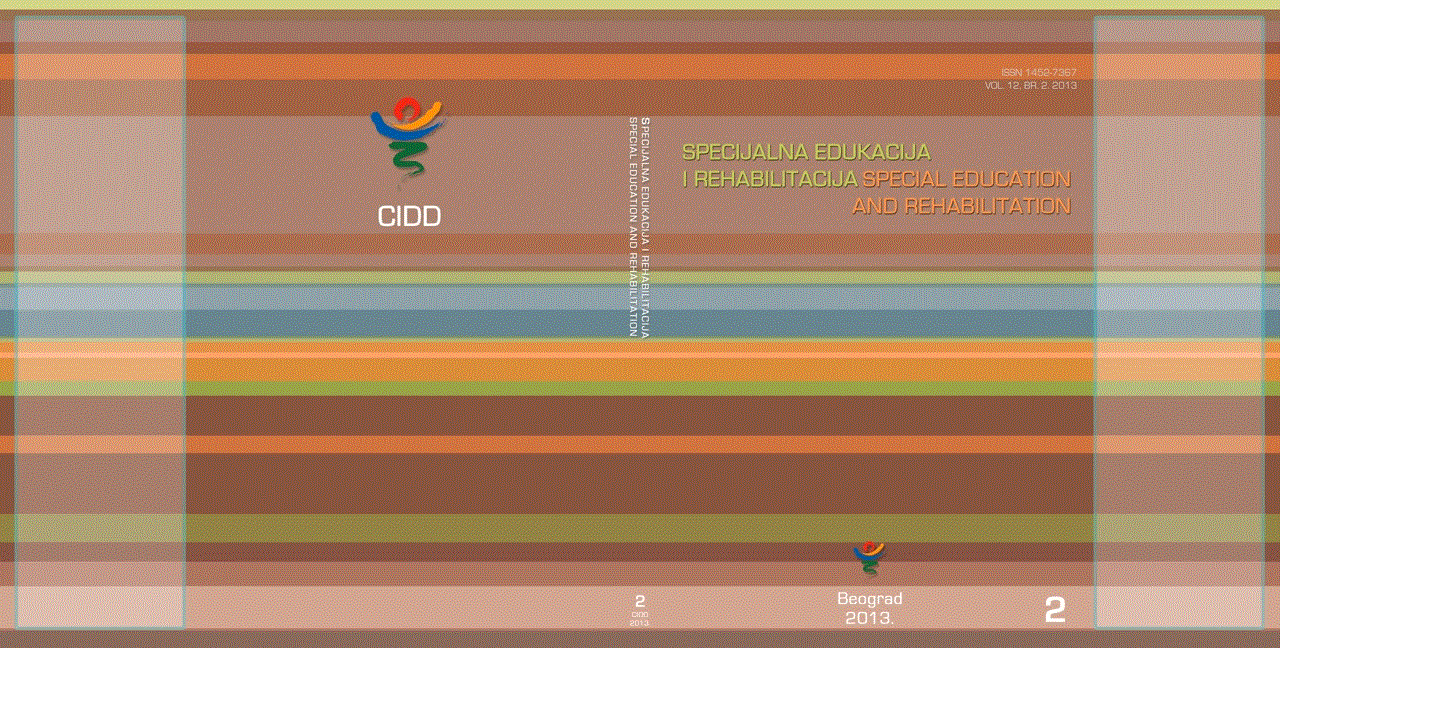FAKTORSKA STRUKTURA TESTA INTERNET ZAVISNOSTI
Sažetak
Jedno od aktuelnih pitanja u oblasti proučavanja poremećaja upotrebe interneta odnosi se na validnost i relijabilnost mernih instrumenata. Cilj istraživanja bio je ispitivanje faktorske strukture Testa internet-zavisnosti (Internet Addiction Test – IAT), kao jednog od najstarijih i najkorišćenijih instrumenata u ovoj oblasti. Uzorak je činilo 814 učenika starijih razreda beogradskih osnovnih škola, prosečne starosti 12.9 godina. Eksploratornom faktorskom analizom izdvojena su dva faktora koja zajedno objašnjavaju 46.32% ukupne varijanse. Prvi faktor, koji u objašnjenju ukupne varijanse učestvuje sa 38.47%, definisan je stavkama koje opisuju nemogućnost kontrole u upotrebi interneta i posledice koje nastaju kao rezultat prekomernog korišćenja interneta, dok drugi faktor, koji objašnjava 7.85% varijanse, čine stavke koje ukazuju na preokupaciju internetom, reakciju na deprivaciju i zamenu realnih socijalnih odnosa virtuelnim. Pouzdanost interne konzistencije cele skale, izražena Kronbahovim alfa koeficijentom, iznosi .91. Visoki koeficijenti pouzdanosti zadržavaju se i na supskalama koje predstavljaju faktor, tako da koeficijent pouzdanosti za prvu skalu iznosi .87, a za drugu .85. Dobijeni nalazi diskutovani su u kontekstu eventualnih modifikacija instrumenta i komparirani sa rezultatima inostranih istraživačkih studija provere validnosti i pouzdanosti IAT na specifičnim nacionalnim uzorcima.
Reference
Blagojević, G. (2011). Internet u savremenim etnološkim i antropološkim istraživanjima. Zbornik Matice srpske za društvene nauke, 134, 17-21.
Brenner, V. (1997). Psychology of computer use: XLVII. Parameters of internet use, abuse and addiction: The first 90 days of the internet usage survey. Psychological Report, 80, 879-882.
Caplan, S. E. (2002). Problematic Internet use and psychosocial well-being: Development of a theory-based cognitive–behavioral measurement instrument. Computers in Human Behavior, 18(5), 553-575.
Chang, M., & Law, S. (2008). Factor structure for Young's Internet addiction test: A confirmatory approach. Computers in human behavior, 24(6), 2597-2619.
Chen, S. H., & Chou, C. (1999). Development of Chinese Internet addiction scale in Taiwan. Poster presented at the 107th Annual Convention of the American Psychological Association, Boston, USA.
Chou, C., & Hsiao, M. C. (2000). Internet addiction, usage, gratification, and pleasure experience: The Taiwan college students' case. Computers and Education, 35(1), 65-80.
Davis, R. A., Flett, G. L., & Besser, A. (2002). Validation of a new scale for measuring problematic Internet use: Implications for pre-employment screening. CyberPsychology and Behavior, 5(4), 331-345.
Ferraro, G., Caci, B., D’amico, A., & Di Blasi, M. (2007). Internet addiction disorder: An Italian study. CyberPsychology and Behavior, 10(2), 170-175.
Goldberg, I. (1995). Internet addictive disorder (IAD) diagnostic criteria. Retrieved January 22, 2013. from http://www.psycom.net/iadcriteria.html.
Greenfield, D. N. (1999). Psychological characteristics of compulsive internet use: A preliminary analysis. CyberPsychology and Behavior, 2(5), 403-412.
Griffiths, M. (1998). Internet addiction: Does it really exist? In J. Gackenbach (Ed.), Psychology and the Internet: Intrapersonal, interpersonal, and transpersonal implications (pp. 61-75). San Diego, CA: Academic Press.
Griffiths, M. D. (2008). Internet and video-game addiction. In C. Essau (Ed.), Adolescent Addiction: Epidemiology, Assessment and Treatment (pp. 231-267). San Diego, CA: Elselvier.
Hinić, D. (2011). Problems with ‘Internet Addiction’ diagnosis and classification. Psychiatria Danubina, 23(2), 145-151.
Internet World Stats (IWS) (2012). Internet usage statistics. Retrieved February 11, 2013. from http://www.internetworldstats.com.
Khazaal, Y., Billieux, J., Thorens, G., Khan, R., Louati, Y., Scarlatti, E., et al. (2008). French validation of the Internet Addiction Test. CyberPsychology and Behavior, 11(6), 703-706.
Kovačević-Lepojević, M. (2011). Pojam i karakteristike internet-zavisnosti. Specijalna edukacija i rehabilitacija, 10(4), 615-631.
Lin, S. S. J., & Tsai, C. C. (1999). Internet addiction among high schoolers in Taiwan. Poster presented at the 107th Annual Convention of the American Psychological Association, Boston, MA, USA.
Morahan-Martin, J. M., & Schumacker, P. (2000). Incidence and correlates of pathological Internet use. Computers in Human Behavior, 16(1), 13-29.
Ngai, S. S. (2007). Exploring the validity of the Internet Addiction Test for students in grades 5-9 in Hong Kong. Journal of Adolescence and Youth, 13(3), 221-237.
Popović-Ćitić, B., Marković, M. i Popović, V. (2012). Zavisnost od interneta – aktuelna saznanja i dileme. U: B. Kordić, A. Kovačević, B. Banović (Ur.), Reagovanje na bezbednosne rizike u obrazovno-vaspitnim ustanovama (str. 261-271). Beograd: Fakultet bezbednosti.
Republički zavod za statistiku (RZS) (2012). Upotreba informaciono-komunikacionih tehnologija u Republici Srbiji, 2012. Retrieved February 11, 2013. from http://webrzs.stat.gov.rs.
Rotunda, R. J., Kass, S. J., Sutton, M. A., & Leon, D. T. (2003). Internet use and misuse: Preliminary findings from a new assessment instrument. Behavior Modification, 27(4), 484-504.
Scherer, K. (1997). College life on-line: Healthy and unhealthy Internet use. Journal of College Student Development, 38(6), 655-665.
Widyanto, L., Griffiths, M. D., & Brunsden, V. (2011). A psychometric comparison of the Internet Addiction Test, the Internet-Related Problem Scale, and self-diagnosis. Cyberpsychology, Behavior and Social Networking, 14(3), 141-149.
Widyanto, L., & McMurran, M. (2004). The psychometric properties of the Internet Addiction Test. CyberPsychology and Behavior, 7(4), 443-450.
Young, K. S. (1996). Internet addiction: The emergence of a new clinical disorder. Paper presented at the 104th Annual Meeting of the American Psychological Association, Toronto, Ontario, Canada. Retrieved February 10, 2013. from http://www.netaddiction.com. Published 2008 in Cyberpsychology and Behavior, 1(3), 237-242.
Young, K. S. (1998). Caught in the net. New York: John Wiley & Sons.
Young, K. S. (2004). Internet addiction: A new clinical phenomenon and its consequences. American Behavioral Scientist, 48(4), 402-415.
Young, K. S. (2008). Assessment of Internet addiction. The Center for Internet Addiction Recovery. Retrieved April 12, 2012. from www.netaddiction.com.
Young, K. S. (2011). Clinical assessment of internet-addicted clients. In K. S. Young, & C. Nabuco de Abreu (Eds.), Internet addiction: A handbook and guide to evaluation and treatment (pp. 19-34). New Jersey: John Wiley & Sons.

